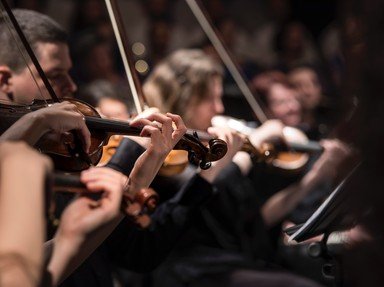Quiz Answer Key and Fun Facts
1. Before the twentieth century, nearly all composers were performers as well. Match the following greats with their respective performance specialisms: Vivaldi, Bach, Beethoven, Berlioz, Wagner, Richard Strauss.
2. Machaut, Dufay, Josquin des Prez and Palestrina all wrote what kind of work?
3. Which of these have not been revived in the twentieth century?
4. Handel was one of the greatest composers of Italian opera of his day.
5. Quite a few composers had other careers on the side - or sometimes it was even their musical careers that were secondary. Can you match the following trades and positions with their composers: prince, politician, fur merchant, insurance company director, naval officer, chemist, priest?
6. In the couple of decades around 1600, English composers wrote far more madrigals in total than their Italian counterparts.
7. Piano is to harpsichord as flute is to....?
8. Tschaikovsky called him a "giftless bastard", a "scoundrel", a "self-inflated mediocrity" and his music "chaotic and absolutely empty dried-up stuff"; Hugo Wolf claimed him as one of the worthiest representatives of the art of composing without ideas; Mahler called him "a puny little dwarf with a rather narrow chest"; and Benjamin Britten didn't mind his bad music, but couldn't stand his good stuff. Who was he?
9. What medical conditions affected respectively Bach, Handel, Beethoven, Schumann and Wolf shortly before they died?
10. He wrote the Eroica, the Emperor and the Archduke. Who was he?
11. Two masterworks, Puccini's "shabby little shocker" and one of Elgar's, both premiered in 1900. What were they?
12. Tonic solfa is derived from a medieval plainchant hymn to St John the Baptist.
13. In Western musical notation, did polyphony (the simultaneous sounding of more than one note) appear before the musical staff/stave of one or more lines?
14. Which of these composers wrote a work called "The Seasons"?
15. The harpsichord and piano are the chief representatives of two of the three main types of keyed stringed percussion instruments. Which instrument is the main representative of the third type?
16. Match these pieces with their nicknames: Haydn's last symphony, no.104 in D major, Beethoven's Piano Sonata op.27 no.2 in c# minor, Tschaikovsky's Symphony no.2 op.17 and Prokoviev's Symphony no.1 in D major.
17. With which monarch were the composers JS Bach, CPE Bach and JJ Quantz, as well as Voltaire, all aquainted?
18. Which composer wrote a piece of music consisting entirely of silence?
19. Match the following Scandinavian countries and Finland with their respective greatest composers: Norway, Sweden, Denmark, Finland.
20. Wagner's father-in-law was....?
21. Finish this quote, by Haydn to Leopold Mozart regarding his son: "I declare to you before God, and as an honest man, that your son...
22. The tone poem "Thus Spake Zarathustra" (Richard Strauss), Albinoni's "Adagio", Borodin's opera "Prince Igor" and Mozart's Piano Concerto no.21 K467 in C major all featured prominently in films and musicals. Respectively, which ones?
23. On the works of which famous literary figure did all of the following composers base at least one of their works: Prokoviev, Mendelssohn, Tschaikovsky, Berlioz, Verdi, Weber, Bellini, Wagner?
24. What is common to all these works: Schubert's 8th, Bruckner's 9th and Mahler's 10th symphonies, Bach's Art of Fugue, Puccini's opera "Turandot", Berg's opera "Lulu" and Schoenberg's opera "Moses and Aaron", and Mozart's Requiem?
25. Which two of these were not JS Bach's sons: CPE, JC, JL, PDQ, WF?
Source: Author
anselm
This quiz was reviewed by FunTrivia editor
Bruyere before going online.
Any errors found in FunTrivia content are routinely corrected through our feedback system.


